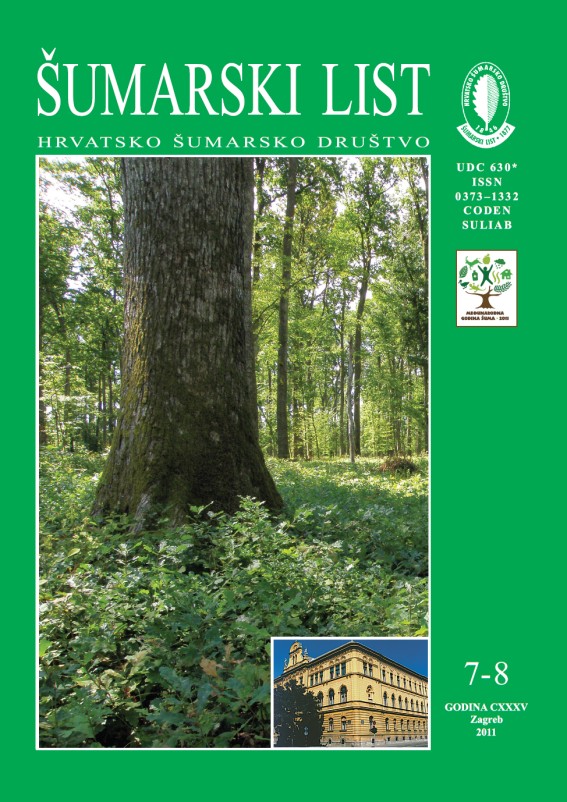| |
| RIJEČ UREDNIŠTVA |
| |
|
|
| EDUCATION AND EMPLOYMENT
pdf
HR
EN
|
341 |
| |
| IZVORNI ZNANSTVENI ČLANCI |
| |
|
|
| Jakovljević,T., M. Gradečki-Poštenjak, I. Radojčić Redovniković | UDK 630* 232.3 (Pinus pinea L.) (001) |
| Physiological, Chemical andAntioxidant Properties of Fresh and Stored Stone Pine Seed (Pinus pinea L.)
pdf
HR
EN
|
343 |
| |
| PRETHODNO PRIOPĆENJE |
| |
|
|
| Mihoci, I., M. Franjević | UDK 630* 453 |
| Rare and Threatened Geometrid Moth Erannis ankeraria in Croatia: Historical Review, data Analysis & Perspectives
pdf
HR
EN
|
353 |
| Kajba,D., J. Domac, V. Šegon | UDK 630* 537 + 238 |
| Procjena potencijala brzorastućih nasada u Republici Hrvatskoj: Primjer razultata u sklopu FP7 projekta Biomass energy Europe
pdf
HR
EN
|
361 |
| Kličić,H., S. Govorčin,T. Sinković, S. Gurda,T. Sedlar | UDK 630* 812 (Pinus sylvestris L.) |
| Macroscopic Characteristics and Density of Scots Pine (Pinus Sylvestris L.) from Cazin, Bosnia and Herzegowina
pdf
HR
EN
|
371 |
| |
| STRUČNI ČLANCI |
| |
|
|
| Barčić, D., N. Panić | UDK 630* 907 |
| Ecological Valorisation of the ProtectedArea of “Kopački Rit” Nature Park
pdf
HR
EN
|
379 |
| Mayer, Željko | UDK 630* 232 (Juglans nigra L.) |
| Establishing Cultures of Black Walnut (Juglans nigra L.) by Generative Propagation
pdf
HR
EN
|
391 |
Summary: Black walnut (Juglans nigraL.) belongs to the genus Juglans, the hickory family (Juglandaceae A. Rich. EX Kunth 1824), which is a representative of the Juglandales order. It is a species that is native to eastern North America that was brought to Europe in 1629. In 1899 the foresters of the great land owner Count Eltz introduced the seed of black walnut to the area of Eastern Slavonia and Syrmia, because of the deterioration of pedunculate oak (Quercus roburL.) and because of the price that the wood of black walnut reaches on the market. Till 1925 the forest management technique applied was the forest-field technique. Already in 1925 black walnut cultures covered around 860 ha. The Counts Eltz from Vukovar planted the seed of black walnut until the Second World War, when they left their land possessions. The cultivation of black walnut cultures continued after the war and intensified in the seventies, when the seed was planted in agricultural areas that were gained by reparcelling and consolidation of holdings. 500 kg of seed per ha is planted in rows with the spacing of 4 and 6 meters. Between the rows agricultural cultures are sown, and after three to four years black locust (Robinia pseudoacaciaL.) is planted. At the end of the twentieth century the growing of black walnut cultures continued and it goes on today. 500 kg of black walnut seed is planted per ha in the same year after the felling of the old-growth forest. The spacing between furrows drawn by disc-plough is four meters, and the seed is planted with a spacing of 25 cm within the row.A kilogram of seed contains around twenty grains on the average, which makes 10.000 grains per hectare. In the next year up to 65% of the grains sprout, and in the second year there are up to 55% or around 5.000 saplings of black walnut on the planted surface. This can guarantee that in the 80th year by efficient management we shall gain 100 to 120 quality trees of black walnut. Since the planting is done immediately after the felling, after a year or two between the rows there is a sufficient number of some of the indigenous or allochthonous tree species, so there is no need for subsequent planting so as to gain a mixed stand. The forestry office of Vukovar currently manages around 1.300 ha of black walnut cultures and the gross growing stock amounts to ca. 200.000 m3. The cultures of black walnut with a rotation period of 80 years reach an average breast height diameter of ca. 42 cm and an average height of ca. 33 m.
Key words: Black Walnut; Eastern Slavonia; North America; planting; tending |



